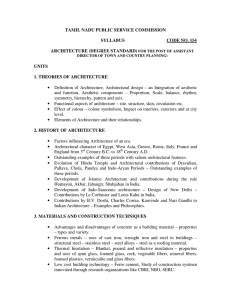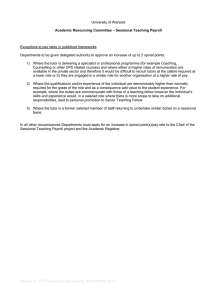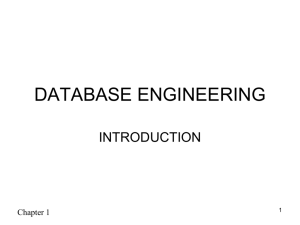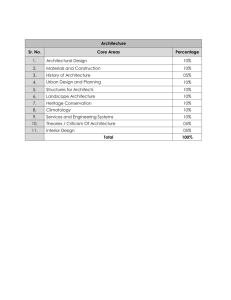Third Semester B.Arch. Architectural Design-II
advertisement
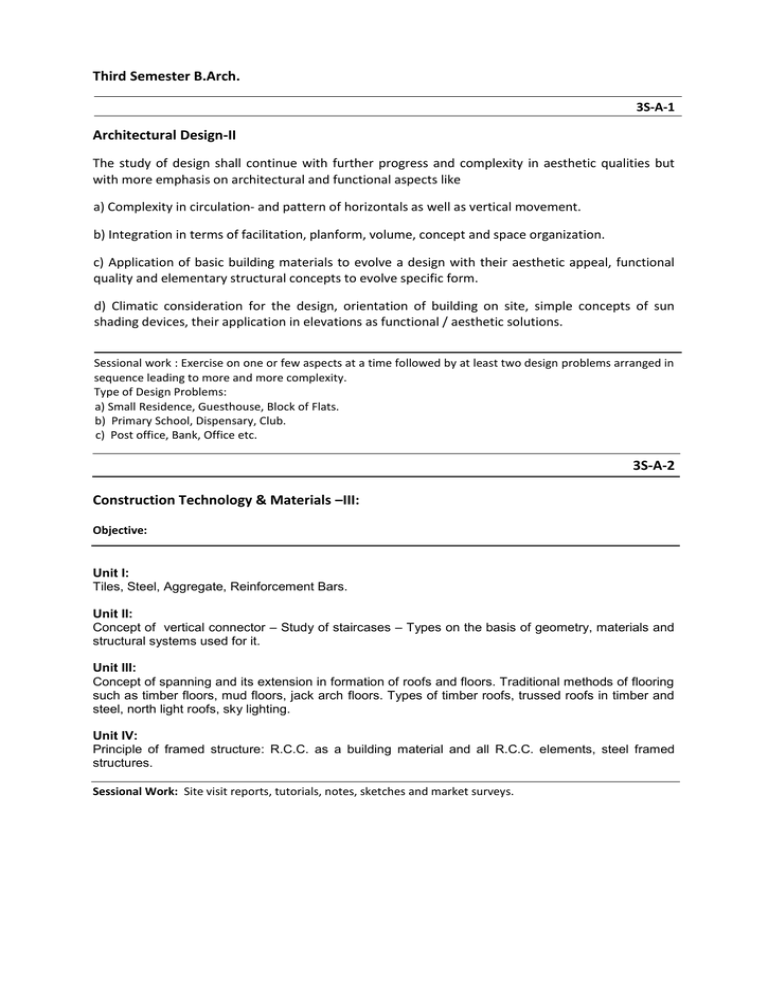
Third Semester B.Arch. 3S-A-1 Architectural Design-II The study of design shall continue with further progress and complexity in aesthetic qualities but with more emphasis on architectural and functional aspects like a) Complexity in circulation- and pattern of horizontals as well as vertical movement. b) Integration in terms of facilitation, planform, volume, concept and space organization. c) Application of basic building materials to evolve a design with their aesthetic appeal, functional quality and elementary structural concepts to evolve specific form. d) Climatic consideration for the design, orientation of building on site, simple concepts of sun shading devices, their application in elevations as functional / aesthetic solutions. Sessional work : Exercise on one or few aspects at a time followed by at least two design problems arranged in sequence leading to more and more complexity. Type of Design Problems: a) Small Residence, Guesthouse, Block of Flats. b) Primary School, Dispensary, Club. c) Post office, Bank, Office etc. 3S-A-2 Construction Technology & Materials –III: Objective: Unit I: Tiles, Steel, Aggregate, Reinforcement Bars. Unit II: Concept of vertical connector – Study of staircases – Types on the basis of geometry, materials and structural systems used for it. Unit III: Concept of spanning and its extension in formation of roofs and floors. Traditional methods of flooring such as timber floors, mud floors, jack arch floors. Types of timber roofs, trussed roofs in timber and steel, north light roofs, sky lighting. Unit IV: Principle of framed structure: R.C.C. as a building material and all R.C.C. elements, steel framed structures. Sessional Work: Site visit reports, tutorials, notes, sketches and market surveys. 3S-A-3 Structural Design & Systems – III Unit I: Principal stresses and strain : Application of Mohr’s Circle method and study of concepts by analytical method. Unit II: Direct and bending stresses: Concept and application Unit III: Stability of Retaining walls : Stresses at base and minimum base width (without surcharge). Unit IV: Stress strain curves for concrete and steel ( MS and TS) Unit V: Column and struts: Eulers and Rankins theory – concept and application Unit VI: Hoop stress / longitudinal stress in cylinders and pipes. Unit VII: Simply supported beams – BM and SF Diagrams, Cantilever beams Sessional work: Sketches, notes, tutorials, tests and presentations 3S-A-4 History of Art & Architecture –III Objective: Study of social changes on architecture Unit I: Islamic Architecture: 11th Century AD. Architectural forms conceived by Qutub Dynasties at Delhi. Unit II: Development of regional styles noticed in various provinces such as Bengal, Jaunpur, Gujrat and Central India. Unit III: Architecture under Mughals - Humayun, Akbar, and Shahjahan. Unit IV: Contemporary Architecture (in West) Unit V: Architecture in Post Independence era, city planning of Chandigarh, Delhi and study of its important administrative buildings. Unit VI: Study of various schools of thoughts and philosophies of modern architects and its impact on contemporary architecture. Unit VII: Industrial revolution in Europe and emergence of the Modern movement and its impact on contemporary Indian Architecture. Contemporary Architecture in India. Study of works of Indian Architects, new developments like Navi Mumbai. Sessional work: Sketches, notes, tutorials, tests and presentations 3S-A-5 Architectural Graphics-III Perspective : Unit-l: Perception and registration of an object when viewed. Unit-II: Introduction to picture planes, standpoint, eye level etc. Unit-III: Types perspective views such as one point, two point, three point, worm’s eye view, Bird's eye view, normal view, etc. Unit-IV: Methods of drawing perspective views such as conventional method, measuring point method, shortcut and approximation in perspective drawing, simple problems based on geometrical solids Unit-V: Measured Drawing: Measurement techniques of existing object (such as building, plot,etc.) and preparing measured drawing to suitable scale. Unit-VI: Sciography: Introduction to Sciography, principle of conventional angle of light and its rays acting as a projectors to cast shadow of simple plane lamina e.g. square, circle, hexagon etc. Sessional work: Sketches, notes, tutorials, tests and presentations 3S-A-6 Surveying & Levelling Unit I: Introduction to surveying and leveling, types of surveying methods and application, Unit II: Chain and compass survey, methods and instruments used, plotting and adjustment of closing error. Unit III: Plane table survey, method and instruments used. Unit IV: Levelling, methods of levelling -dumpy level and its uses. Unit V: Contours, use of theodolite, contour survey. Unit VI: Planimeter and its use. Practicals: a) Chain and compass survey, traversing. b) Plane table survey of cluster of buildings. c) Levelling using dumpy level and water table. d) Setting out site layout. e) Contour survey, plotting contour maps. Sessional work: Practical record book, plates and notes . 3S-A-7 Climate and Architecture Objective: This part of the subject provides a scope to apply the knowledge of basic Climatology gained earlier for designing in different climatic conditions, with emphasis on tropical climate. Unit I: Study of traditional / vernacular architecture in relation with the climate types, with emphasis on vernacular architecture in Indian Context. Unit II: Understanding climate data, its analysis and method of presentation. Unit III: Study of passive cooling techniques, techniques of solar radiation control and heat transfer and insulation. Unit IV: Study of effect of orientation, topography, vegetation, form, building materials and surfaces on the building design in response to the climate. Unit V: Approach to climate responsive built environment. Sessional work: Notes, Plates, Case studies etc. Sessional work: Notes, plates, practicals & case study. 3S-AA-1 Elective a - environmental studies/ rural architecture/ vernacular architecture/ environmental impacts 3S-AA-2 Elective b - history of Indian traditional art and crafts/art appreciation/ architectural documentation/critical appreciation Fourth Semester 4S-A-1 Architectural Design III This course will be in continuation with the previous semester i.e. Architectural Design II Sessional work: Assignments on each head with presentation, lecture and site visits. Design of simple single activity spaces like residence, school, canteen etc. Small modules of short design projects based on the understanding developed about above mentioned topics. 4S-A-2 Construction Technology & Materials –IV Unit I: Metals: Aluminium, copper, steel, titanium etc. Unit II: Doors Windows – Steel, aluminium and sliding doors, sliding and folding doors, revolving doors, revolving shutters, collapsible gates. Unit III: Partitions – Aluminium, timber, steel. Unit IV: Temporary Structures and temporary supports – Timbering to trenches, formwork, centering, shoring and underpinning. Sessional Work: Site visit reports, tutorials, notes, sketches and market surveys. Plates of Small modules of design based on the construction principles. 4S-A-3 Structural Design & Systems- IV Unit I: Concept of fixity – independent fixed beams with different loadings - BM and SF diagrams. Unit II: Concept of continuity – three moment theorem - BM and SF diagrams. Unit III: Method of Moment distribution for a) For continuous beams b) Single portal frames BM. And SF. Diagrams. Unit IV: Deflection of beams – simple supported and cantilever beams by using Macaulay’s method. Unit V: Determinate and indeterminate structures – degree of indeterminacy. Unit VI: Study of Arches a) Study of behaviour fixed arch and Two hinged arch. b) Analysis of three hinge arches. Unit VII: Study of IS 875 Part I, Part II and Part III Unit VIII: Concept of load distribution for structural systems and overall stability like: a) One way b) Two way c) Suspension Structures d) Arch Action Sessional works: Sketches, notes, tutorials, tests and presentations 4S-A-4 Building Services–I Objective: Aim of this subject is make the students aware of the importance, installation and working of essential services in buildings, and a way building services help in generating a cleaner and healthier built environment. The students should also be made familiar with I.S. codes related to services. The first part deals with the basic aspects of water supply, sewage disposal, refuse and storm water disposal in buildings. Unit I: General idea of sources of water supply, qualitative & quantitative aspects, impurities, hard & soft water, standards for quality of water. Study of standards regarding water demand and consumption in different types of buildings, computing demands for domestic use, connection from municipal supply, domestic water supply systems, types, capacity-design-construction of suction & storage tanks. Unit II: Down take supply, water supply pipes, and their sizes, jointing, fixing and laying. Various valves, fittings and fixtures like taps, showers etc. Domestic hot water supply system, water heaters. Unit III: Principles of sanitation, water carriage systems, collection of waste matter in buildings. Various sanitary fittings and fixtures like water closets, urinals, wash hand basins, sinks, flushing cisterns, shower trays, bath tubs, bidets, drinking water fountains etc. Unit IV: Various traps and their function, sewage collection and disposal system for individual buildings. Various types of sanitary pipes and their jointing, fixing and laying, manholes, inspection chambers, intercepting chambers. Unit V: Self cleansing velocity, invert levels, drains on sloping sites, sewage disposal system in unsewered localities- septic tank, soak pits, cesspools, aqua-privy, leeching pits for individual building of urban and rural areas. Unit VI: Refuse disposal- Sources, types, collection, storage and transport, provisions for refuse disposal individual building level, refuse chutes. Storm water drainage- collection and disposal. Sessional works: Sketches, notes, tutorials, tests and plates 4S-A-5 Architectural Graphics IV Sciography: Unit-1: Study of visual effects of shades and shadows when cast by Sight rays on solids and planes. Unit–2: A principle of conventional angle of light and its rays acting as a projector to cast a shadow on simple geometrical object including shadow cast partly on horizontal and vertical plans. Unit-3: Study of combination of shades and shadows. Unit-4: Complex problems on-buildings, building projections, louvers, chajjas, canopies etc. rendered in appropriate medium. Unit-5: Study of shades and shadows cast by artificial light on solids and planes. Perspective : Unit-6: Perspective of interior of buildings rendered suitably. Unit-7: Parallel and angular exterior perspective views of objects of buildings in different materials rendered with appropriate colours showing shades and shadows. Unit-8: Bird's eye view showing a building or any object with surrounding landscape, buildings etc. rendered Sessional works: Sketches, notes and plates 4S-A-6 Theory of Design-I Unit I: Introduction to Architectural Design: Definition of Architecture; Elements of Architecture backed by need and followed by fulfilment of need. Unit II: Scope of Architectural Design: Architectural Design – An analysis – Integration of aesthetic and function Unit III: Architectural Space and Mass: Mass and space, Visual and emotional effects of geometric forms and their derivatives – Sphere, Cube, Pyramid, Cylinder, Cone, etc. Unit IV: Aesthetic Components of Design Proportion, Scale, Balance, Rhythm, Symmetry, Hierarchy, Pattern, Axis with building examples. Unit V: Application of Colour in Architecture Effect of colour in architecture – Colour symbolism Sessional work: Notes, case studies and presentations 4S-A-7 Theory of Landscape Architecture Objectives: The scope of the subject is to make students aware of architecture beyond buildings, in the outdoor environment and spaces, and, the role and importance of landscaping and site planning in enhancing and improving the quality of building environs, functionally and aesthetically. Unit I: Introduction to Landscape Architecture, definitions, importance, need and scope. Levels of landscape planning and design. Landscape architecture and ecology. Relationship between landscaping and environmental planning, regional planning, urban planning, urban design , architecture and interior design. Unit II: Historical development of landscape architecture. Origins of gardens. Design Principles, salient features and elements of various gardens in history - like Egyptian, Persian, Spanish, Italian, French, English, American, Japanese, Moghul Indian etc. Unit III: Modem garden development. Changed scenario for modern garden designs. Effect of industrialization on garden designs. Company towns, parks movement, green belts, urban parks, residential gardens, small gardens. Unit IV: Different factors and components of a landscape. Social and economical factors. Psychological considerations of spaces and enclosures. Brief idea about man made components like walls, fences, entrances, gates, barriers, screens, planters, roads & pathways, street furniture, signage, services-electrical, water supply and drainage. Basic natural components - land, trees, water and climate. Unit V: Land. Different aspects of land as a landscape element - soils, geology, topography, earth forms, levels, foundations, grading, drainage, paved and unpaved surfaces. The importance and use of the aspects as a landscape design element. Unit VI: Plants. Different aspects of trees, shrubs, climbers, hedges, lawns as landscape elements. Basic horticultural idea about plants, plant selection, planting design and care of plants. Importance and use of the aspects as a landscape design element. . Unit VII: Water. Various forms 'of water elements in a landscape - fountains, waterfalls, pools, cascades, channels irrigation etc. Importance and use of water as a landscape design element. Construction of various water elements. Unit VIII : Climate. Macro and micro-climatic considerations in landscape architecture. Effect of climate on landscape and various components of landscape on the microclimate. Relationship between climate and landscape and architecture. Reference Books: Landscape Architecture By J.O.Symonds.McOraw Hill Publications. Earthscape by J.O,Symonds,McGraw Hill Publications, Architecture-A manual of site planning and design by J.O.Symonds, McgrawHill Publications, Site Planning by Kevin Lynch, Site Planning by R.Genebrooks, Prentice Hall. Sessional Work: Notes, sketches, tests and seminars based on the above topics. 4S-A-8 Elective a - graphic softwares/ web design/ building simulations and modeling/ 4S-A-9 Elective b - anthropometrics and ergonomics/ product design/ design of building elements
